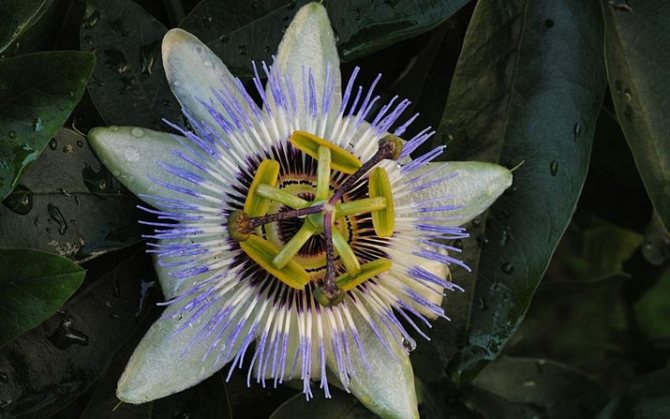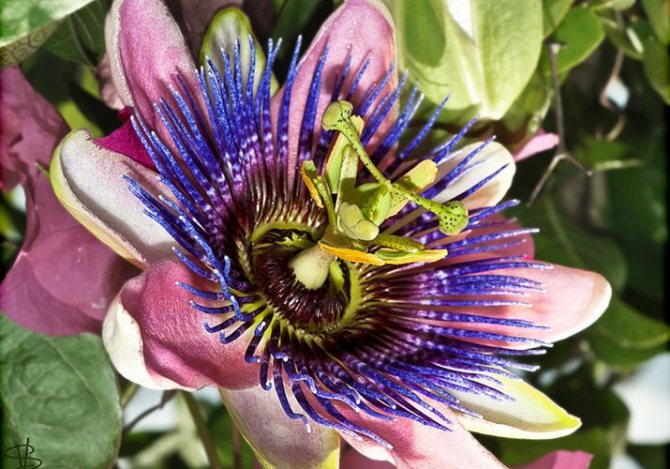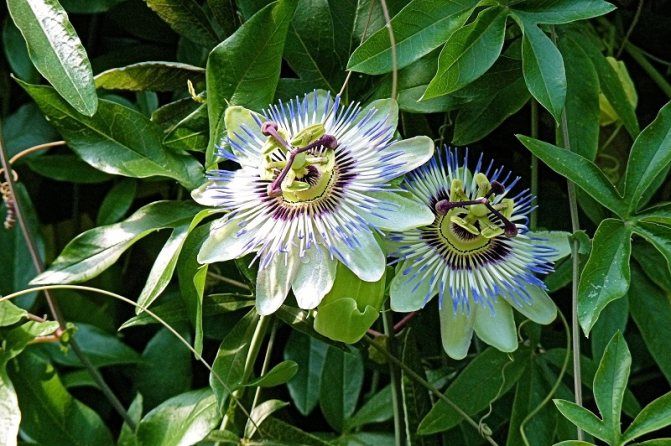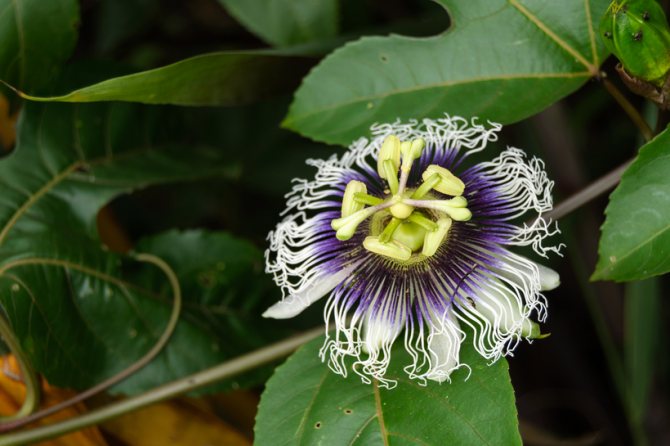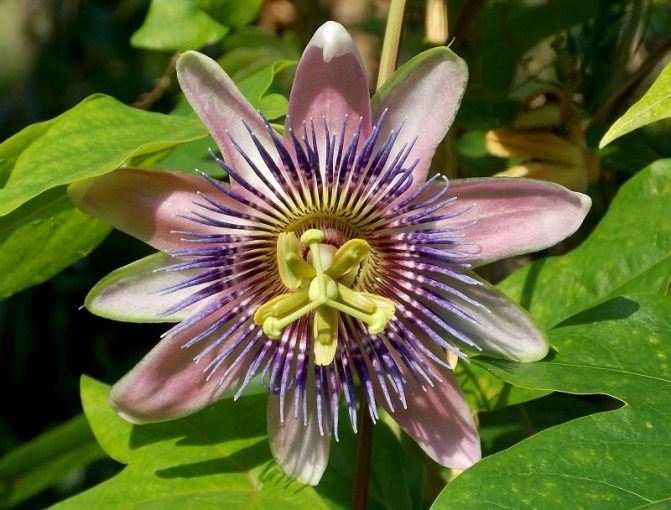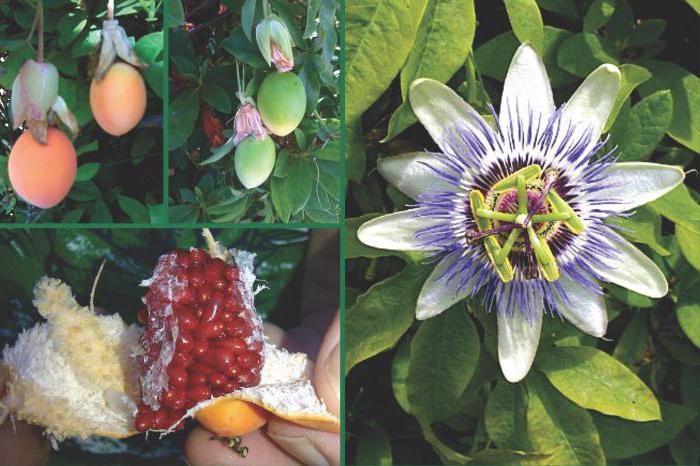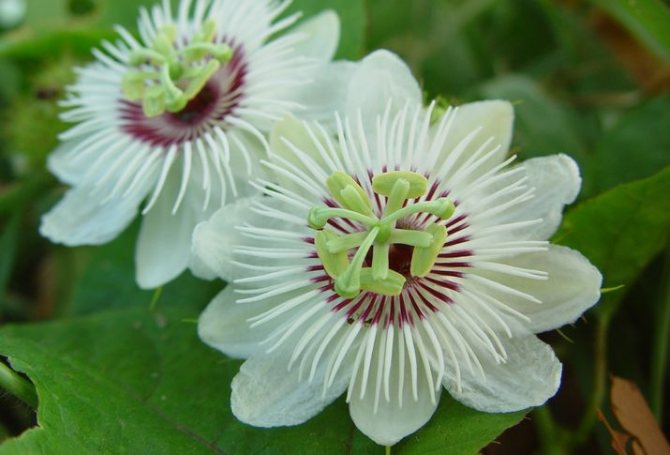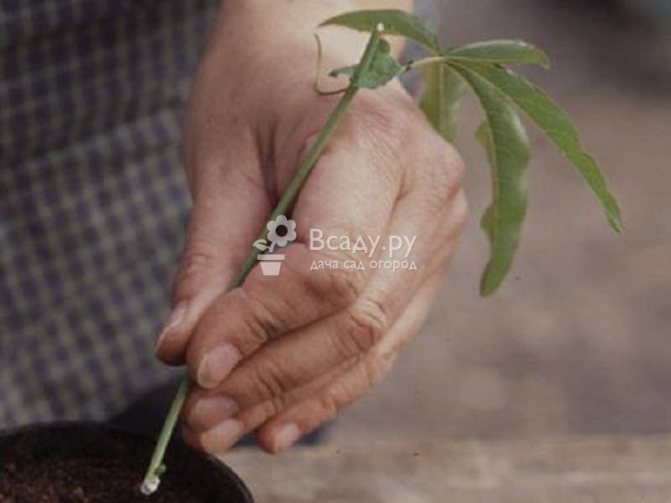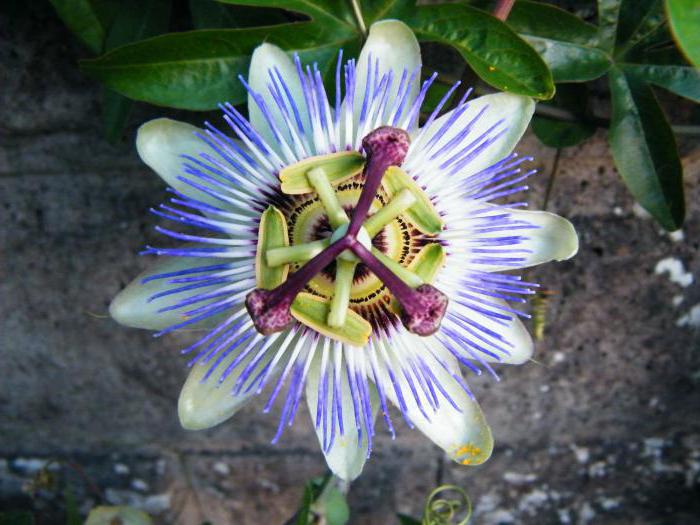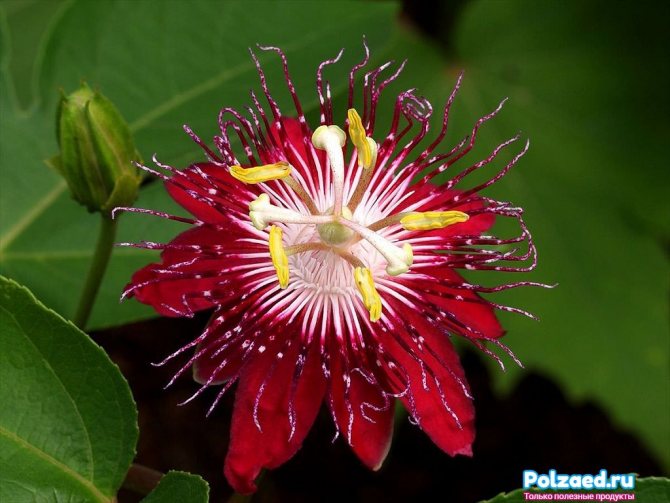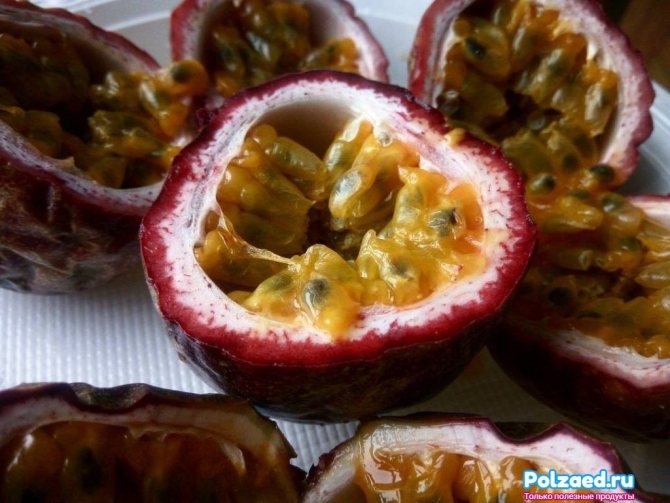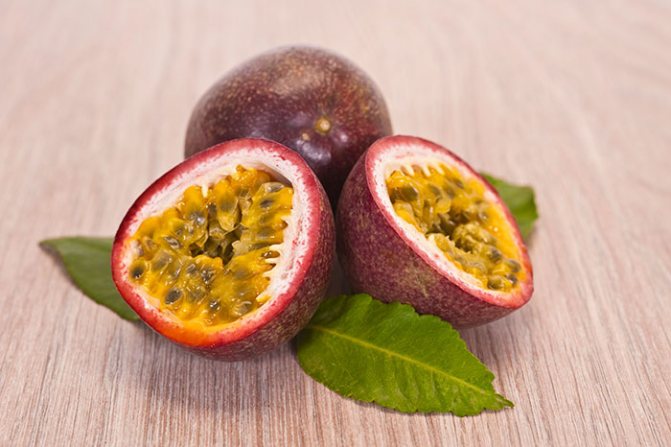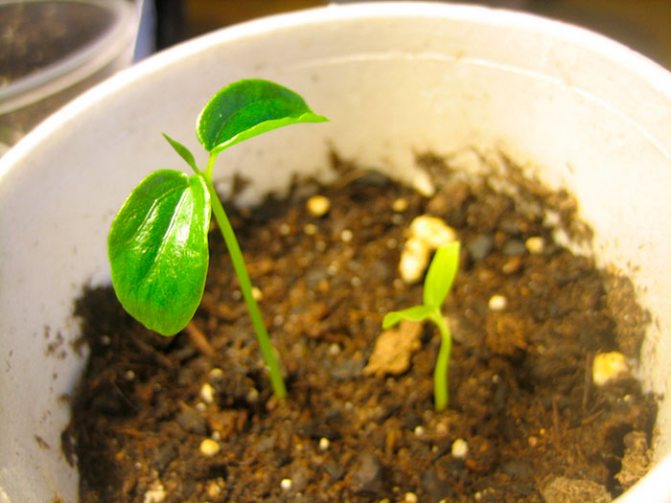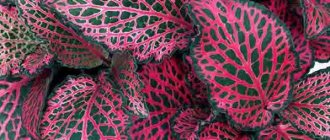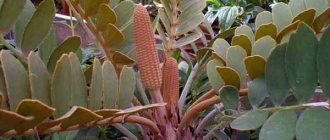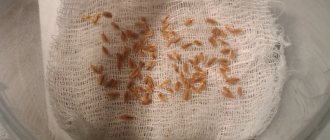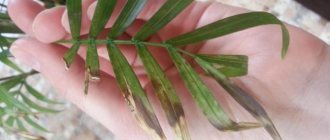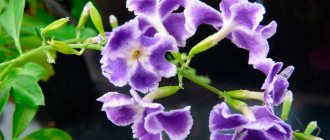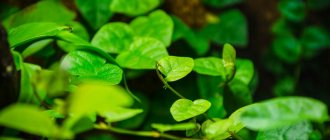The passionflower plant in nature is an evergreen climbing shrub or herbaceous plants, annuals and perennials, with woody stems. Passion flower leaves are simple, dark green, lobed or whole. Large, axillary, star-shaped, brightly colored outlandish flowers up to 10 cm in diameter grow on long pedicels. They have five petals - according to the number of Christ's wounds, five sepals, large bracts, in the center of the flower - an ovary with three stigmas, and around them - five stamens with large anthers. Many species of flowers emit a pleasant aroma, but unfortunately they are short-lived. Passionflower usually blooms from July to October. Large, up to 6 cm in length, fragrant fruits of passionflower are edible in many species. Fast-growing and non-capricious homemade passionflower is grown as an ampelous plant.
Passion flower has large bright flowers that resemble a star. Passionflower was brought to Europe from the countries of South America, Australia, Asia and the island of Madagascar. Most of the species grows in tropical America, especially in Brazil and Peru, few species are found in tropical Asia and Australia, in the Mediterranean, and one species on the island of Madagascar. Cultivated in a subtropical climate in the Caucasus.
The Spaniards associate this flower with a crown of thorns, the Japanese associate it with a clock, and in Russia it was given the name "cavalier's star", which, perhaps, most accurately defines its essence. It really looks a lot like an order, what do you think? Even among the people, it is customary to call passionflower a passion flower - isn't it a very eloquent name?
By the way, you may well know passionflower by the name of the edible fruits of some of its species - granadilla and passion fruit. Yes, the one in yoghurt.
Homemade passionflower or passionflower - description, photo
Passion flower has smooth stems that can be more than ten meters in length. It has whole or lobed dark green simple leaves and long pedicels that form unusual star-shaped flowers up to 10 cm in diameter. The flowers have five sepals, five petals and large bracts. In the center of each bud there are three stigmas, which are surrounded by five stamens with rather large anthers.
When does passion flower (passionflower) bloom? Flowering begins in July and continues throughout the summer. In some species, large edible fruits are formed after flowering. Both flowers and fruits have a pleasant aroma.
According to signs, passion flower is a flower of loyalty and reverence. Popular rumor says that if a fan gives a woman a passion flower, then he offers her a long relationship that will be sensual and trusting.
What does it look like
Passion flower has over 400 species. Edible passionflower is the most common of them. Passionflower is an ampelous (climbing) plant, so a hanging pot will become the most comfortable home for it. The stalks of the wildly climbing passionflower fall out of the planter like yeast dough rising in a saucepan. Their luscious green color fits perfectly into the interior decoration of the house. And the flowers, which have a completely cosmic look and strong aroma, become the real pride of an amateur florist.You can judge the beauty of a plant by the characteristics from the table.
Table - Appearance and features of passion flower
| Part of the plant | Features of the |
| Liana | - Evergreen; - the leaf plate consists of three blades 20 cm in length; - the edge of the leaf is cut with small teeth |
| Flower | - Single; - inflorescence diameter - 3 cm; - 5 sepals; - 5 petals; - 5 very fragile stamens |
| Fetus | - Egg-shaped; - as a rule, yellow (but the color can be any, up to dark purple); - full ripening of the fruit occurs 2-3 months after pollination |
Passionflower - species, photos
There are a large number of species of this plant, the cultivation of which can be done not only at home, but also in the garden. Some of them perfectly withstand frosts down to -15 degrees.
The most popular types are:
Blue passionflower - This is a liana with greenish-blue or purple large single flowers. It has woody stems and orange fruit-berries.

Passionflower or passion fruit blooms with creamy white flowers. It has large, fragrant edible fruits that can be used to make desserts and drinks.


Passionflower three-lane - This species got its name because of the three stripes located on the leaves. The plant has pale yellow flowers with a scent of lilac and gray fruits.
Passionflower incarnata - liana with stems 6 to 10 meters long. The petals of its flowers are most often purple, but they can also have a different color. Slightly sour lemon-yellow fruits have a pleasant taste. The dried leaves and stems of this species are used to make tea, which helps in the treatment of epilepsy, insomnia, neuroses and other diseases.
Passionflower tetrahedral - a large plant, the shoots of which can reach 15 meters in length. It blooms in large flowers with a diameter of up to 15 cm. After flowering, large oval fruits are formed, which have a sweet juicy pulp and a thick rind. Fruits are formed only in greenhouses. At home, they are rarely tied.
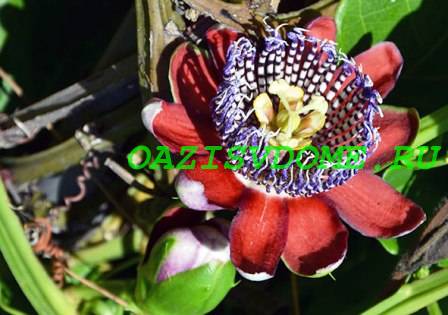

Passionflower graceful - the species is distinguished by single white-greenish flowers, shallowly dissected three-lobed smooth leaves and red-coral fruits with a large number of seeds.
You will be interested to know: Gerbera room after purchase: transplantation and care at home
Passionflower laurel Is a plant with leaves that look like laurel leaves.
Passionflower tender or banana - liana is distinguished by large pink flowers and fleshy fragrant fruits. These fruits contain a large amount of organic acids. Already in the first year of life, the plant produces a large number of fruits.
Use in landscape design
The tropical visitor is the perfect plant to create a Mediterranean-style garden. Together with decorative nightshade, lavender, daylilies and sciadopitis, it will create the atmosphere of a southern landscape. Passion flower in pots looks beautiful on the terrace or near the house.
Exotic plants
Although passionflower is native to the tropics, some species of this plant grow well and winter outdoors in regions with mild winters. In the conditions of the middle lane, only frost-resistant species of passionflower can winter.
Passiflora grown outdoors should be cut in the fall to a height of 15-20 cm. Then they are dug up and transplanted into a container that must be kept in a cool room until spring. In springtime, the plant is planted in open ground, and it grows and blooms throughout the summer. When the garden passionflower has faded, it should be brought back into the house.
Passionflower - home care
Growing passion flower requires certain conditions and rules for caring for a flower.This plant loves good lighting, so you need to place it near the southwest or southeast window. You can put the flower on the southern windowsill, but in summer it should be shaded so that the leaves and buds do not burn direct sunlight.
Temperature and humidity
During the warmer months, a tropical vine will grow and bloom well on an open balcony or garden.
At home, the air temperature should be within + 24 ... + 27 degrees. Such a tropical plant does not tolerate extreme heat, drafts and stagnant stuffy air.
In winter, the passion flower has a dormant period, during which it needs to provide an air temperature from +15 to +18 degrees. At this time, he is gaining strength before flowering.
Passion flower loves high humidity, so every evening its leaves are sprayed with water at room temperature. It is necessary to ensure that no water gets on the flowers.
If in winter the liana is kept at room temperature with the heating radiators turned on, then in addition to spraying, it is recommended to arrange a warm shower for the bush once a week. This should be done carefully so as not to break the shoots.
Watering
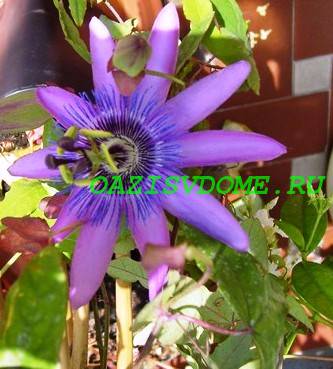

When growing passionflower at home, its large leaves evaporate a lot of moisture, which is why the plant should be watered regularly. No need to wait for the soil to dry out. After watering, be sure to drain the water from the pan.
In winter, in cool conditions, watering is reduced. Moisten the soil only after the top layer dries out.
Top dressing
During the growing season, that is, from spring to autumn, the flower is fed every 10-14 days. For this, complex mineral and organic fertilizers are alternated. The quality of flowering is influenced by potassium, and more nitrogen is used for the growth of vines and the formation of leaves. During the dormant period and if the plant is sick, fertilizers are not applied.
Growing tips
Despite the fact that passionflower is a thermophilic vine, it can be successfully grown in our climate. It is enough to provide the exotic with the appropriate conditions and during the flowering period we will be able to admire its beautiful flowers without any problems. Some species, for example, P. incarnata and blue (P. caerulea), tolerate prolonged temperature drops to -15 ° C. The rest of the species must be brought into the house for the winter.
Liana needs a sunny warm place, fertile loose soil with the addition of peat, leafy soil and coarse sand for good water permeability, since the perennial does not tolerate stagnation of water near the roots. It is advisable to provide the plant with increased air humidity by periodically spraying it with warm water.
Prop and trim
Long stems of vines grow quickly, so they need support. Shoots should be regularly directed towards the support. Without it, under the weight of leaves and flowers, the shoots will break.
Pruning passionflower
Home care for passionflower involves pruning. It is held every year, which stimulates intensive growth and branching of the vine. The first time pruning of shoots is carried out when the plant reaches three years of age.
Pruning procedure:
- In the spring, last year's shoots are cut by 1/3. Young shoots do not need to be touched, since it is on them that buds will form.
- In summer, growth grows at the base of the bush, which takes away its strength. It needs to be cut out.
- When the plant stops flowering, the secondary bald long shoots are cut out completely, and the remaining ones are shortened by 3/4 dynes.
Healing properties of fruits
The plant has been considered medicinal since ancient times. Passionflower fruits (passion fruit), which give some types of plants, are a storehouse of useful substances. They contain:
- vitamin A;
- vitamin C;
- all B vitamins.
The peel of the fruit is rich in ascorbic acid and is an invariable ingredient in vitamin complexes and dietary supplements. Indoor vine leaves can be used as a pain reliever. They are thoroughly kneaded, and then applied to a sore spot or wound. In the old days, medicines based on passionflower were used to treat menstrual pain, insomnia, and even dysentery.
South American residents give passion fruit to their children before bed. This fruit is rich in soothing substances. Therefore, passionfruit juice is a natural medicine for hyperactive children.
Transfer
Young plants are transplanted into a new pot every year, and adults - once every 2-3 years. The pot is selected small. The new container should be just a couple of centimeters larger than the previous one. Otherwise, the plant will grow roots and greenery, and flowering will have to wait a long time.
Soil for passionflower can be bought at a store or mixed by yourself from the following ingredients:
- peat land;
- leafy land;
- sod land;
- sand.
All components are taken in equal parts and mixed. A drainage layer is poured onto the bottom of the new pot, then a layer of soil, on which a bush is carefully placed, together with an earthen lump. The roots around and above are covered with soil, and watered with water at room temperature.
Attention! During flowering, passionflower cannot be rearranged from place to place, otherwise it will drop the buds!
Passion flower diseases and pests
Spider mites, aphids, thrips, mealybugs, whiteflies - the activity of each representative of this "company" poses a certain danger to the plant. However, all the problems associated with insect pests (except for the mealybug) can be solved instantly by using such insectoacaricides as "Aktellik", "Fitoverm", "Aktara". Mealybug is very sensitive to drugs that contain cypermethrin - "Arrivo", "Inta-vir". Passionflower is susceptible to certain infections. Among them are bacterial, ring and brown spots, root rot, late blight, fusarium, scab and yellow mosaic virus. Most often, the disease turns out to be stronger, and there is no chance of curing the flower: the plant, along with the pot, must be destroyed in order to exclude the possibility of contamination of other indoor flowers.
Reproduction of passionflower
Homemade passion flower can be propagated in two ways:
- seeds;
- cuttings.
Passionflower from seeds at home
It is recommended to buy seeds in the store, since the planting material collected from its own fruits quickly loses its germination. Purchased seeds require processing before planting:
- First of all, you need to damage the hard shell of the seeds, for which they are rubbed with a fine skin.
- Soak the planting material for two days in warm water with a temperature of +25 degrees.
- The floating seeds are thrown away, and the swollen ones are gently pressed into the prepared moist soil.
From above, the crops are sprayed with warm water from a spray bottle and covered with cling film, polyethylene or glass. In such a greenhouse there will be air humidity necessary for better germination of seeds. Seedling containers are placed in a warm place (+ 20 ... + 25 degrees) with diffused light. When caring for crops, they must be ventilated every day and, as necessary, moisten the soil.
Seedlings may appear in a month or even a year. When the seeds hatch and seedlings appear, the shelter is removed and the seedlings are provided with daylight hours at 12 o'clock. For this, you can use additional lighting.
After the appearance of two true leaves on young plants, a pick is carried out. Seedlings are planted in separate containers together with an earthen clod. In order not to disturb them with a pick, you can plant the seeds in peat tablets.
Passionflower grown from seeds will bloom in about eight years.
Where to buy passionflower seeds
The Scientific and Production Association "Sady Rossii" has been introducing the latest achievements in the selection of vegetable, fruit, berry and ornamental crops into the wide practice of amateur gardening for 30 years. In the work of the association, the most modern technologies are used, a unique laboratory for microclonal reproduction of plants has been created. The main tasks of NPO Sady Rossii is to provide gardeners with high-quality planting material for popular varieties of various garden plants and novelties of world selection. Delivery of planting material (seeds, onions, seedlings) is carried out by Russian post. We are waiting for you for shopping: NPO "Sady Rossii"
Propagation of passionflower by cuttings
In spring, young shoots can be cut off and used for propagation. Each stalk must have a growing point and at least four leaves.
Rooting process of cuttings:
- The lower leaves are removed and the lower part of the shoot is treated with Kornevin or another root former.
- The tanks are filled with a mixture of black soil and sod land. Potting soil can be purchased at your local specialty store.
- Using a pencil or stick, a hole is made in the ground to the very bottom of the container, into which the shoot is inserted. The two remaining leaves should be flush with the soil surface.
- A greenhouse is being built over the cuttings, for which polyethylene or cling film is stretched over the arched wire frame.
- The cuttings are placed in a warm place with an air temperature of +21 degrees. They should not be exposed to direct sunlight.
- Planting care consists in their daily airing and timely soil moistening.
- After three weeks, the shelter is removed.
- You can root the cuttings in a solution of water with a piece of charcoal. During rooting, the water does not change.
You will be interested to know: Gloxinia: care and cultivation at home
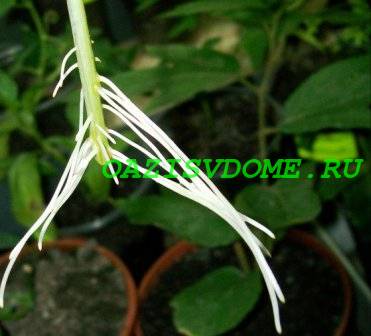

After about one and a half to two months, when the roots grow, the shoots are planted in pots with soil for passionflower.
The use of passionflower in homeopathy and its medicinal properties
Almost any starflower is fraught with healing properties. Passionflower is included in tea collections and a number of medications used in medicine for the treatment of insomnia, certain diseases of the nervous system, epilepsy, stabilizing blood pressure, normalizing hormonal balance and relieving asthmatic attacks.
In homeopathy, various preparations with passionflower are made (for example, Edas-111), which additionally have an analgesic and antispasmodic effect. Passion flower liquid extract is prescribed for increased excitability and irritability.
Although passionflower carries beneficial properties, you cannot use it without consulting a doctor, since its use has many contraindications.
It is not recommended for people suffering from gastritis, stomach ulcers, arrhythmias, angina pectoris, low blood pressure, atherosclerosis, as well as those who have suffered myocardial infarction. And in no case should you self-medicate children and pregnant women.
Growing problems
Caring for passionflower requires compliance with all the rules, otherwise you may encounter some problems.
Passionflower does not bloom
The flower needs a dormant period, during which it gains strength for flowering. When grown in winter in warm home conditions, flowering may be poor or absent altogether. Also, if passion flower does not bloom, you should pay attention to the following points:
- is there good lighting;
- whether the plant has enough moisture and nutrition;
- excess nitrogen in fertilizers leads to foliage build-up, and buds may not form.
Passiflora leaves turn yellow
The yellow leaves of the plant first of all need to be examined for the presence of pests on them.Dry air in an apartment and other unfavorable conditions can cause spider mites, whiteflies, mealybugs and thrips to appear on the vine. All of them feed on the sap of the plant, as a result of which the leaves first turn yellow, then dry and fly around. Pests can be destroyed by treatment with special insecticidal preparations.
Other causes of yellowing of leaves include:
- insufficient lighting;
- lack of trace elements;
- excess moisture, in which yellow spots first appear on the leaves.
Do not worry if the old lower leaves turn yellow and fall off in an adult bush. This is a natural process.
Passiflora leaf tips dry and darken
This means that the room has low air humidity, which causes the plant to suffer. In such conditions, he needs regular spraying.
However, the leaves can darken due to overdrying or waterlogging of the soil. If the darkened leaves began to fall off intensively, care should be reconsidered.
Droplets on the leaves
A natural feature of liana is the appearance at the base of the leaves of sweet nectar in the form of droplets. But it can stand out profusely if the room is stuffy and hot or the pot is in the sun, which causes the soil to overheat.
Passionflower drops buds
During the flowering period, the plant does not like changes, therefore, improper watering, drafts, lowering the air temperature and rearranging the pot to another place can cause the buds to drop.
The second reason - why the passion flower buds are shed, is a lack of light and nutrition.
Choosing the right variety of passionflower for outdoor use
If you plan to grow the bush outdoors, pay attention to the passionflower variety. Despite the fact that passionflower is a very unpretentious plant, not all of its types are suitable for growing in the Moscow region.
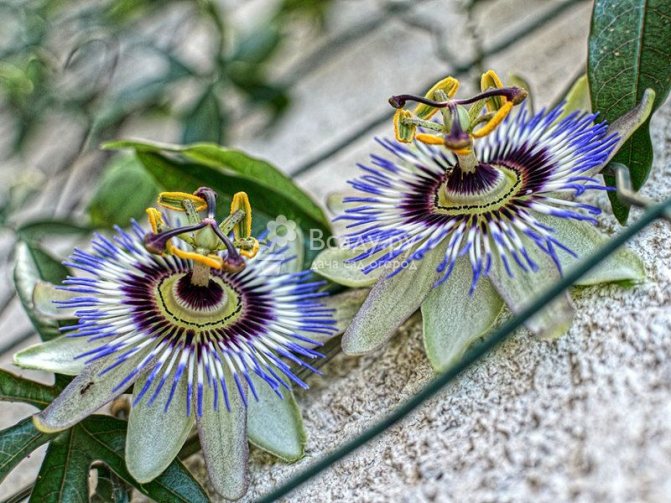

Passionflower blue is suitable for outdoor cultivation
The most suitable variety for open ground is blue passionflower (Latin Passiflora caerulea). The leaves and flowers of this species have a blue tint. Three-striped passionflower (Latin Passiflora trifasciata) and banana passionflower (Latin Passiflora mollissima) are recommended to be grown indoors.
Is it possible to get fruits and how to do it
The flowering of young passionfruit begins quite quickly: many vines throw out the original buds already in the first year after the first season of life. Young liana often reaches 1 m or more.
For active flowering and the appearance of juicy fruits on the Passion fruit tree, you will need a self-pollinating variety or artificial pollination even on dioecious plants. You need to carefully transfer pollen from male flowers to female flowers and hope for a positive result.
Do not despair if you cannot grow fruits. The evergreen liana Passion fruit, even without exotic fruits on the branches, has a high decorative effect. Ejection of buds is much easier to achieve, the flowers of a tropical plant are unusual, large and very beautiful.
Contraindications
There are few contraindications to the use of granadilla. The main one is possible individual intolerance that can cause allergic reactions. As with other exotic fruits, the use of passion flower should be treated with caution, especially at the first meeting. For the same reason, you should not eat it during pregnancy and breastfeeding. You can not give it to children under three years old because of the possibility of allergies and side effects from the digestive tract. Overripe fruits have a strong laxative effect, so they should not be overused. They should not be eaten by people who have a tendency to frequent indigestion and other digestive problems. It is not recommended to often eat passion fruit for people suffering from high acidity of the stomach: an abundance of acids can provoke an exacerbation of the problem. Another side effect is drowsiness caused by granadilla seeds.A small amount will help cure insomnia, but frequent or excessive use will cause an obsessive feeling of sleepiness.
Miracles on the counter
For some time now, the range of plants sold has greatly increased, thanks to imports from Europe. However, some, including myself, are unhappy with the species and varietal composition of plants sold in almost every flower shop. Therefore, enthusiastic people are looking for new ways to get something new, unusual and exotic, and one of these ways is an ordinary trip to the supermarket.
In addition to the classic apples, pears, bananas and citruses, you can find there something that we see and hear about for the first time. And I advise you never to pass by the counter with exotic fruits and vegetables, believe me, there are some interesting things! In this article, I will describe my experience of planting seeds from store-bought fruits.
Recipes


The exotic sweet and sour taste of passionfruit allows it to be used as an addition to main dishes, salads and desserts. Refreshing cocktails and tinctures are made from granadilla juice. It goes well with freshly squeezed orange, kiwi and mango juices. Sour varieties are suitable for meat and fish dishes. The original solution is a Caribbean-style sauce of granadilla puree, mango cubes, bacon, hot chili and salt, stewed for 5-7 minutes. Also, the fruit is often added to salsa sauce or, mixed with salt and pepper, is served as an independent topping. A favorite use of passion fruit is adding fruit pulp to sweet dishes: yoghurts, cakes, pies, curd casserole. An interesting option is granadilla mousse:
- Knead 1 banana, 2 ripe granadilla with a fork and mix.
- Pour 25 grams of melted butter into the resulting mixture.
- Stir and refrigerate for 30 minutes.
- Grind 1 large kiwi with a fork until smooth.
- Whisk fresh cream with granulated sugar.
Put kiwi in layers in beautiful shapes, then a mixture of banana-passionfruit, decorate with whipped cream on top. Serve the dish immediately after cooking so that the foam does not fall, and the granadilla and banana puree retains a pleasant freshness.
Granadilla is an exotic fruit with an interesting history and an abundance of beneficial properties. Due to the difficulties of delivery, it is difficult to find ripe fruit in supermarkets, so during your vacation you should not deny yourself the pleasure of eating this alluring fruit.
Name
There are more than 500 species of granadilla, therefore the plant has many names: passion flower, passionflower, passion fruit. The last option is the most authentic, since it comes from the Spanish language, because it was the Spaniards who first brought the fruit to the Old World from the New. Granadilla comes from the French grenadille, which means "pomegranate". It was named so because of the association generated by the abundance of seeds in these fruits. Of greatest interest is the name "passion flower", because in English granadilla is called passionfruit, or "passion fruit". This is associated with the erroneous opinion that it is an aphrodisiac: in fact, such properties of the plant are not known to medicine. The name is associated with religion - the Passion of Christ, which he experienced during the crucifixion. And the word "passion" in the name of the plant does not mean "attraction" but "suffering." This theory was put forward in 1610 by the church leader and historian Giacomo Bosio from Italy, who called the passionfruit flower the living embodiment of the Savior's suffering. He mistook the outer and inner crown for a crown of thorns, three pistils for the nails with which Jesus was nailed to the cross. The leaves with pointed ends symbolized the spear that pierced the body, and the glands located on their inner side symbolized the pieces of silver that Judas received.
How, when, how much is
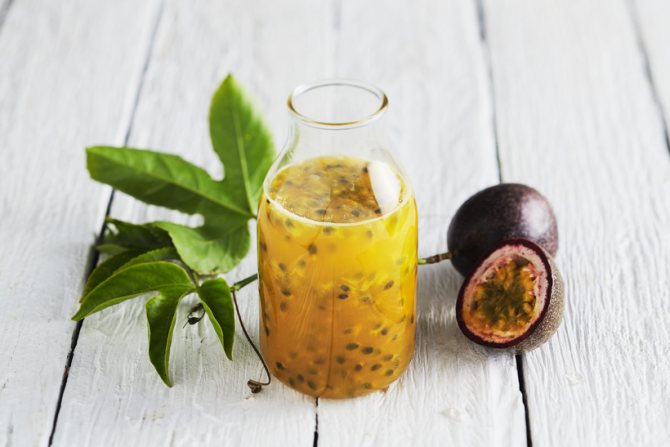

In tropical countries, granadilla ripens twice a year: a bountiful harvest begins at the end of the rainy season, which should be taken into account when buying fruits during an overseas vacation. You can find fruits in supermarkets all year round, but they are unlikely to be as tasty. The reason is simple: it is difficult to deliver them ripe without damage or deterioration. It is not recommended to eat the peel: to keep the fruit longer, it is treated with chemicals. Peeling passion fruit is easy: with a sharp knife, you need to make a continuous cut 3-5 mm deep along the entire fruit in order to divide it into 2 halves. It is most convenient to eat the pulp with a teaspoon, without separating it from the seeds. They are soft and easy to chew without causing discomfort or harm to the stomach. Sour varieties can be flavored with sugar or honey. The original way of using it is with pepper and salt. This is how granadilla is eaten in the Philippines and Thailand.
You can eat the fruit at any time of the day: its pulp pleasantly refreshes without leaving a feeling of heaviness. However, it is worth considering the effect of drowsiness that the seeds give: if your body is sensitive to it, you should use passion fruit in the evening, as a light sleeping pill and sedative.
Benefit and harm
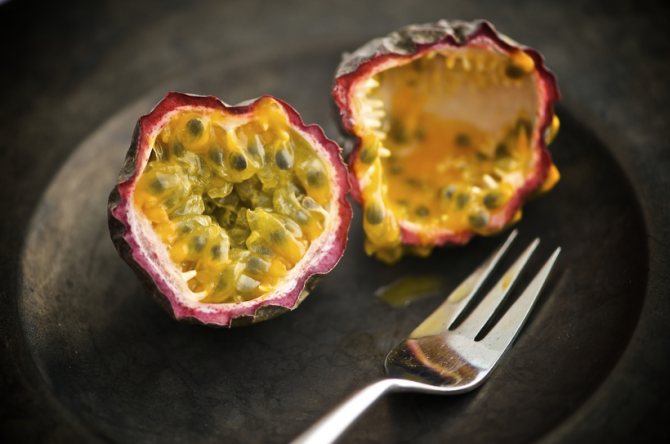

Passion fruit is a low-calorie food that is often included in diets. It contains almost no fat, and the optimal balance of proteins and carbohydrates provides the body with building materials and energy. Caloric content, depending on the variety, varies from 46 to 65 kcal
Granadilla is useful for the prevention and treatment of many diseases:
- Eliminates headaches, migraines, spasms. Regular use normalizes sleep, helps in the fight against insomnia.
- The soothing effect of passionfruit is also noticed: it gives lightness and relieves stress. The reason for this is the presence of magnesium in the composition, which has a beneficial effect on the nervous system.
- Due to the sodium content in the fruit, it has a diuretic effect, which, if necessary, allows you to remove excess fluid from the body.
- The fruit is indicated for people with cardiovascular disease and hypertension.
- Promotes the elimination of toxins and toxins, an abundance of fiber perfectly cleanses the digestive tract.
With moderate use and the absence of allergies, granadilla cannot bring harm, however, a number of contraindications exist.
The unsolved mystery of the flower
But passionflower amazes us not only with flowers.
To save itself from caterpillars, insect pests, it accumulates poisonous substances in the leaves (tannins, alkaloids, phenols, saponins and, mainly, cyanides).
Only caterpillars of butterflies heliconidsdue to the peculiarities of their metabolism, they are not afraid of these substances.
Eating on the leaves of passionflower, they accumulate them in their body and themselves become so poisonous that any predator, having tried such a caterpillar once, dies.
As you can see, heliconides in the struggle for survival managed to use the features of the plant. Nobody feeds on them, therefore, unlike other caterpillars, they do not hide even during the day.
These butterflies are the only pollinators of amazing flowers. They contribute to the pollination of flowers and the formation of seeds, are the main link in the reproduction of plants, which provides a food base for their caterpillars.
The plant amazes with its extraordinary abilities - on the leaves it forms patterns of egg-laying heliconids so similar to the real ones that you can distinguish them from the genuine ones only through a magnifying glass, and even then not always! A butterfly, seeing these drawings, does not leave egg-laying on these leaves.
The deceived butterfly flies away, and the stately and proud passionflower remains intact, leaving us with a new mystery.
But such patterns on the leaves are formed only when at least one brood of caterpillars has walked over the plant with its voracious jaws.
Memo to the florist
The lethargic appearance of the flower is not always a symptom of the disease. Sometimes you just need to adjust some of the conditions of detention so that the plant is pleasing to the eye.
Why doesn't passion flower bloom?
For flowers to bloom, the place of detention must be sufficiently light. Unopened buds can also indicate a lack of nutrients in the substrate. The plant especially needs fertilization during the summer months.
How to correctly transplant azalea at home, read the link
What if the leaves dry or wither?
Passionflower is moisture-loving, however, from excessive watering, the leaves can fade and turn yellow. You cannot fill the flower. A drainage layer must be present in the pot so that excess water can drain off.
Seedling container
The choice of dishes in which the seeds will initially be planted is an individual choice. Some prefer individual cultivation, others - mass cultivation. In accordance with the choice of capacity, the number of seeds that will be planted also depends. Pots, disposable cups, or food trays are most commonly used.
One of the most popular and reliable methods of growing passionfruit is coconut briquette, which, according to the prototype of a peat tablet, initially has a compact shape, which, when immersed in water, increases several times and turns into an excellent container for growing individual passionfruit seeds.
I bought, ate, planted ...
In the above-mentioned passifloras (we will call them that), there are seeds inside, surrounded by an amniotic membrane containing thick juice. Seeds can be planted immediately, or they can be stored in a dry place, they retain their germination for a long time. But they can rise in different ways. Usually, the first shoots appear in three weeks, but even if your expectation in the specified period was not justified, do not despair! Keep the soil moist as before, the process of germinating the seeds can take up to six months. But the seedlings that were born are quite strong, and at the same time grow quickly. The most important thing is not to flood at the very beginning of their life.
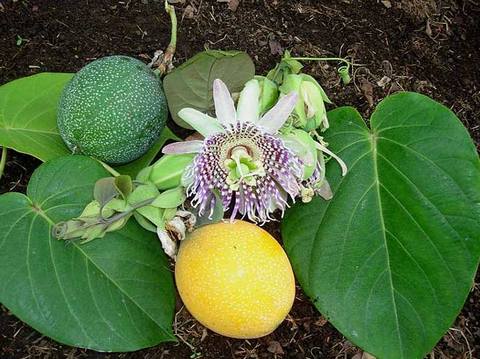

Granadilla (Passiflora ligularis)


Granadilla (Passiflora ligularis)





